981365006f64d45f88e53943e2cfce56.ppt
- Количество слайдов: 90
 An intro to Scratch Notes and Tasks for ITEC-I 5 Camp Leaving lots of exploration for the future. ITEC-I 5 Scratch Aug 2009 1
An intro to Scratch Notes and Tasks for ITEC-I 5 Camp Leaving lots of exploration for the future. ITEC-I 5 Scratch Aug 2009 1
 What are our goals? n n n Learn some computing concepts. Use Octave as computing tool. Use Scratch as computing and multimedia tool. Have fun with Scratch creating stories, games, art. Learn some computing concepts. ITEC-I 5 Scratch Aug 2009 2
What are our goals? n n n Learn some computing concepts. Use Octave as computing tool. Use Scratch as computing and multimedia tool. Have fun with Scratch creating stories, games, art. Learn some computing concepts. ITEC-I 5 Scratch Aug 2009 2
 Who computes? n n n n Scientists Engineers Businessmen Social scientists Artists FBI agents Brain surgeons Grandkids ITEC-I 5 Scratch Aug 2009 3
Who computes? n n n n Scientists Engineers Businessmen Social scientists Artists FBI agents Brain surgeons Grandkids ITEC-I 5 Scratch Aug 2009 3
 Monday concepts (20 min) What is an algorithm? An algorithm for an average and min An algorithm for sorting ITEC-I 5 Scratch Aug 2009 4
Monday concepts (20 min) What is an algorithm? An algorithm for an average and min An algorithm for sorting ITEC-I 5 Scratch Aug 2009 4
 Algorithm for computing the average of two numbers n n Let the first number be A; say A=12 And the second number be B; say B=15 To compute the average _______ So the average of 12 and 15 = ____ ITEC-I 5 Scratch Aug 2009 5
Algorithm for computing the average of two numbers n n Let the first number be A; say A=12 And the second number be B; say B=15 To compute the average _______ So the average of 12 and 15 = ____ ITEC-I 5 Scratch Aug 2009 5
 What algorithm for the average of two people? n n Input this Do precisely that Output what 12 15 ITEC-I 5 Scratch Aug 2009 6
What algorithm for the average of two people? n n Input this Do precisely that Output what 12 15 ITEC-I 5 Scratch Aug 2009 6
 problem: finding min n n n Person B is the “ref” watching A. Person A has list of numbered cards, but cannot look at all the numbers. A can look at 2 numbers at a time only -- one card in each hand. A must find the min of all cards. Exchange roles, with A the “ref” and B “the player”. HOW TO ALWAYS FIND THE MIN? ITEC-I 5 Scratch Aug 2009 7
problem: finding min n n n Person B is the “ref” watching A. Person A has list of numbered cards, but cannot look at all the numbers. A can look at 2 numbers at a time only -- one card in each hand. A must find the min of all cards. Exchange roles, with A the “ref” and B “the player”. HOW TO ALWAYS FIND THE MIN? ITEC-I 5 Scratch Aug 2009 7
 Problem: team finding the min n n n Person A can look at no numbers! No numbers can be seen by A, ever! Person B can look at only two numbers on cards given by person A. Person B gives back to A first the card with the smaller number (if numbers are = then it doesn’t matter which is given first) Person A must find the min and show it to the instructor WITHOUT EVER SEEING IT A and B should switch roles and repeat. ITEC-I 5 Scratch Aug 2009 8
Problem: team finding the min n n n Person A can look at no numbers! No numbers can be seen by A, ever! Person B can look at only two numbers on cards given by person A. Person B gives back to A first the card with the smaller number (if numbers are = then it doesn’t matter which is given first) Person A must find the min and show it to the instructor WITHOUT EVER SEEING IT A and B should switch roles and repeat. ITEC-I 5 Scratch Aug 2009 8
 Problem: how to sort? Use set of cards for each team. How can A sort using B as comparer? ITEC-I 5 Scratch Aug 2009 9
Problem: how to sort? Use set of cards for each team. How can A sort using B as comparer? ITEC-I 5 Scratch Aug 2009 9
 Sorting two-person game n n n This is a 2 -person exercise. To solve the sorting puzzle, person A must form an ordered list of cards, which the instructor will check for order (this is the OUTPUT). Person B can only compare two numbers by seeing the numbers. Person B gives A the smaller number card first (precise operations). Person A can only ask Person B which of two cards has the smaller number. Person A never looks at any numbers. To solve the sorting puzzle, person A must start from an unordered list of cards (this is the INPUT). ITEC-I 5 Scratch Aug 2009 10
Sorting two-person game n n n This is a 2 -person exercise. To solve the sorting puzzle, person A must form an ordered list of cards, which the instructor will check for order (this is the OUTPUT). Person B can only compare two numbers by seeing the numbers. Person B gives A the smaller number card first (precise operations). Person A can only ask Person B which of two cards has the smaller number. Person A never looks at any numbers. To solve the sorting puzzle, person A must start from an unordered list of cards (this is the INPUT). ITEC-I 5 Scratch Aug 2009 10
 Sorting by selecting minimum n n Spread out list of number cards 31, 22, 13, 32, 11, 23, 33, 12 Select the minimum and begin a new list 11 Select the min of what’s left and add it to the end of the new list. 11, 12, Repeat this process until the original list is empty and the new list has all the cards. 11, 12, 13, 21, 22, 23, 31, 32, 33 ITEC-I 5 Scratch Aug 2009 11
Sorting by selecting minimum n n Spread out list of number cards 31, 22, 13, 32, 11, 23, 33, 12 Select the minimum and begin a new list 11 Select the min of what’s left and add it to the end of the new list. 11, 12, Repeat this process until the original list is empty and the new list has all the cards. 11, 12, 13, 21, 22, 23, 31, 32, 33 ITEC-I 5 Scratch Aug 2009 11
 Problem: what is the average of our class? n n How do we define this? . . compute this? An algorithm computes some output from the given input using precise steps that a machine can follow ITEC-I 5 Scratch Aug 2009 12
Problem: what is the average of our class? n n How do we define this? . . compute this? An algorithm computes some output from the given input using precise steps that a machine can follow ITEC-I 5 Scratch Aug 2009 12
 Students use Octave (10 min) Verify the work and problem solutions as below [while the instructor leads]. ITEC-I 5 Scratch Aug 2009 13
Students use Octave (10 min) Verify the work and problem solutions as below [while the instructor leads]. ITEC-I 5 Scratch Aug 2009 13
 Compute the average of two numbers using Octave n n sum = 12 + 15 sum = 27 average = sum/2 average = 13. 500 n n sum is a variable; set its value to 12+15 average is another variable; set its value to the value of sum divided by 2 ITEC-I 5 Scratch Aug 2009 14
Compute the average of two numbers using Octave n n sum = 12 + 15 sum = 27 average = sum/2 average = 13. 500 n n sum is a variable; set its value to 12+15 average is another variable; set its value to the value of sum divided by 2 ITEC-I 5 Scratch Aug 2009 14
 Octave has many useful ops n n n It can operate on numbers -- +, /, sqrt It can operate on lists of numbers – min, max, length, mean Use Octave as needed in camp and after! ITEC-I 5 Scratch Aug 2009 15
Octave has many useful ops n n n It can operate on numbers -- +, /, sqrt It can operate on lists of numbers – min, max, length, mean Use Octave as needed in camp and after! ITEC-I 5 Scratch Aug 2009 15
 g. Kids = 10 n 13 11 >> length(g. Kids) n ans = 5 n >> sum(g. Kids) You can use the ages of the actual group present. n ans = 59 n >> avg. Age = sum(g. Kids)/length(g. Kids) n 12 13 Precise steps to compute the output from the input. The input is the list of ages; the output is the average of all the ages in the list. avg. Age = 11. 8000 ITEC-I 5 Scratch Aug 2009 16
g. Kids = 10 n 13 11 >> length(g. Kids) n ans = 5 n >> sum(g. Kids) You can use the ages of the actual group present. n ans = 59 n >> avg. Age = sum(g. Kids)/length(g. Kids) n 12 13 Precise steps to compute the output from the input. The input is the list of ages; the output is the average of all the ages in the list. avg. Age = 11. 8000 ITEC-I 5 Scratch Aug 2009 16
 sort a list into order n >> g. Kids n g. Kids = 10 13 n >> sort(g. Kids) n ans = 10 n >> min(g. Kids) n ans = 10 n >> max(g. Kids) n ans = 13 n >> 13 11 11 12 What algorithm does MATLAB use to sort the list? 12 13 13 What algorithm finds the min? What algorithm finds the max? ITEC-I 5 Scratch Aug 2009 17
sort a list into order n >> g. Kids n g. Kids = 10 13 n >> sort(g. Kids) n ans = 10 n >> min(g. Kids) n ans = 10 n >> max(g. Kids) n ans = 13 n >> 13 11 11 12 What algorithm does MATLAB use to sort the list? 12 13 13 What algorithm finds the min? What algorithm finds the max? ITEC-I 5 Scratch Aug 2009 17
 There are MANY sorting algorithms. Recursively selecting the min is a BAD algorithm when the list is big. Computer scientists know many different algorithms, some good for small and some good for big lists. ITEC-I 5 Scratch Aug 2009 18
There are MANY sorting algorithms. Recursively selecting the min is a BAD algorithm when the list is big. Computer scientists know many different algorithms, some good for small and some good for big lists. ITEC-I 5 Scratch Aug 2009 18
 Start scratch and let’s go! (90 min) n n Click on the cat icon If not on desktop, download from www. scratch. mit. edu Scratch programming environment comes up quickly We will first do simple ops ITEC-I 5 Scratch Aug 2009 19
Start scratch and let’s go! (90 min) n n Click on the cat icon If not on desktop, download from www. scratch. mit. edu Scratch programming environment comes up quickly We will first do simple ops ITEC-I 5 Scratch Aug 2009 19
 Goals for Scratch n n Learn about objects and behavior Programming motion and sound Programming user interaction Creating your own story, game, entertainment piece, or simulation (starting Wednesday) ITEC-I 5 Scratch Aug 2009 20
Goals for Scratch n n Learn about objects and behavior Programming motion and sound Programming user interaction Creating your own story, game, entertainment piece, or simulation (starting Wednesday) ITEC-I 5 Scratch Aug 2009 20
 PREFACE n n These slides are intended to be used in an active lab demo and discussion and are therefore not complete by themselves. Scratch has a nice facility for working with sounds; however, during the intro only the instructor’s computer should have speakers. When students get to individual work later, they can use headsets and microphones. ITEC-I 5 Scratch Aug 2009 21
PREFACE n n These slides are intended to be used in an active lab demo and discussion and are therefore not complete by themselves. Scratch has a nice facility for working with sounds; however, during the intro only the instructor’s computer should have speakers. When students get to individual work later, they can use headsets and microphones. ITEC-I 5 Scratch Aug 2009 21
 Simple ops first n n Sprites are objects We operate on their color, size, position We move them We have them say things ITEC-I 5 Scratch Aug 2009 22
Simple ops first n n Sprites are objects We operate on their color, size, position We move them We have them say things ITEC-I 5 Scratch Aug 2009 22
 Click on the “Looks” button at the top left. ITEC-I 5 Scratch Aug 2009 23
Click on the “Looks” button at the top left. ITEC-I 5 Scratch Aug 2009 23
![Major components n n At right: the stage with sprite[s] or objects or actors Major components n n At right: the stage with sprite[s] or objects or actors](https://present5.com/presentation/981365006f64d45f88e53943e2cfce56/image-24.jpg) Major components n n At right: the stage with sprite[s] or objects or actors At left: operations and attributes for the sprites Center: scripts or program[s] for the behavior[s] of the sprites Your sprites are actors that you direct with your scripts ITEC-I 5 Scratch Aug 2009 24
Major components n n At right: the stage with sprite[s] or objects or actors At left: operations and attributes for the sprites Center: scripts or program[s] for the behavior[s] of the sprites Your sprites are actors that you direct with your scripts ITEC-I 5 Scratch Aug 2009 24
 The “hello” script n n n Can do it in 57 languages – java, C++, … Scratch Easy in Scratch: select “Looks” operations and drag the “hello operation” onto your center panel. Then double click on this “lego block”: check your sprite behavior at the right Your very first Scratch program! ITEC-I 5 Scratch Aug 2009 25
The “hello” script n n n Can do it in 57 languages – java, C++, … Scratch Easy in Scratch: select “Looks” operations and drag the “hello operation” onto your center panel. Then double click on this “lego block”: check your sprite behavior at the right Your very first Scratch program! ITEC-I 5 Scratch Aug 2009 25
 Make the cat 50% larger 1. Select “Looks” operations 2. Drag the “change size” operator into your script 3. Click and edit for a 50% change (increase) 4. Double click your one operation script 5. Did your cat sprite get 50% bigger? ITEC-I 5 Scratch Aug 2009 26
Make the cat 50% larger 1. Select “Looks” operations 2. Drag the “change size” operator into your script 3. Click and edit for a 50% change (increase) 4. Double click your one operation script 5. Did your cat sprite get 50% bigger? ITEC-I 5 Scratch Aug 2009 26
 Putting a sprite in a location n n Motion ops Go to x , y Set x to Set y to Glide to X is + X is – Y is + Origin is (0, 0) X is – X is + Y is - ITEC-I 5 Scratch Aug 2009 27
Putting a sprite in a location n n Motion ops Go to x , y Set x to Set y to Glide to X is + X is – Y is + Origin is (0, 0) X is – X is + Y is - ITEC-I 5 Scratch Aug 2009 27
 Your sprite’s “attitude” Try a “move op” to see changes. Try “rotation ops” as well. Choose “Motion” ops Click on “attitude variables” ITEC-I 5 Scratch Aug 2009 28
Your sprite’s “attitude” Try a “move op” to see changes. Try “rotation ops” as well. Choose “Motion” ops Click on “attitude variables” ITEC-I 5 Scratch Aug 2009 28
 Locating your sprite Interesting task: make your own “glide to” operation and have your sprite glide to (200, -100) ITEC-I 5 Scratch Aug 2009 29
Locating your sprite Interesting task: make your own “glide to” operation and have your sprite glide to (200, -100) ITEC-I 5 Scratch Aug 2009 29
 Scripting a sequence of ops n n n Do ops in the following order by dragging operation blocks into a single connected block Say hello Move 200 steps forward Grow 50% bigger Make the “meow sound” ITEC-I 5 Scratch Aug 2009 30
Scripting a sequence of ops n n n Do ops in the following order by dragging operation blocks into a single connected block Say hello Move 200 steps forward Grow 50% bigger Make the “meow sound” ITEC-I 5 Scratch Aug 2009 30
 Result of 4 operation script ITEC-I 5 Scratch Aug 2009 31
Result of 4 operation script ITEC-I 5 Scratch Aug 2009 31
 Some new operations color change (Looks) • • wait (Control) • move (Motion) ITEC-I 5 Scratch Aug 2009 32
Some new operations color change (Looks) • • wait (Control) • move (Motion) ITEC-I 5 Scratch Aug 2009 32
 Exercise: write a script to n n n Make the cat move along a square path Say “hi” at all four corners Wait 3 seconds at each corner Change color at all four corners Double size when back to the original starting location. Say “That’s all folks” when done. Show an instructor that you have achieved this. ITEC-I 5 Scratch Aug 2009 33
Exercise: write a script to n n n Make the cat move along a square path Say “hi” at all four corners Wait 3 seconds at each corner Change color at all four corners Double size when back to the original starting location. Say “That’s all folks” when done. Show an instructor that you have achieved this. ITEC-I 5 Scratch Aug 2009 33
 Using variables n n Script might have to remember information How far is the cat from the dog? How fast is the rocket moving? Where did the user click on the stage? ITEC-I 5 Scratch Aug 2009 34
Using variables n n Script might have to remember information How far is the cat from the dog? How fast is the rocket moving? Where did the user click on the stage? ITEC-I 5 Scratch Aug 2009 34
 Let’s implement an algorithm to average two numbers n n Make a variable “number 1” (click and drag and set) Make another one “number 2” ITEC-I 5 Scratch Aug 2009 35
Let’s implement an algorithm to average two numbers n n Make a variable “number 1” (click and drag and set) Make another one “number 2” ITEC-I 5 Scratch Aug 2009 35
 Compute average first as sum n n n Make variable average Drag a “set operation” to script area Drag a + operation Drag variables number 1 and number 2 to parameters Click to execute ITEC-I 5 Scratch Aug 2009 36
Compute average first as sum n n n Make variable average Drag a “set operation” to script area Drag a + operation Drag variables number 1 and number 2 to parameters Click to execute ITEC-I 5 Scratch Aug 2009 36
 Average script as 4 operation sequence. Change the two numbers and click the sequence to execute the block again. ITEC-I 5 Scratch Aug 2009 37
Average script as 4 operation sequence. Change the two numbers and click the sequence to execute the block again. ITEC-I 5 Scratch Aug 2009 37
 Elements of Scratch: objects n n n n Colors Sounds We want to use Scratch to program with Locations in 2 D space multimedia. Sprites Costumes Variables (to remember the state of things) Events: that are broadcast for communication ITEC-I 5 Scratch Aug 2009 38
Elements of Scratch: objects n n n n Colors Sounds We want to use Scratch to program with Locations in 2 D space multimedia. Sprites Costumes Variables (to remember the state of things) Events: that are broadcast for communication ITEC-I 5 Scratch Aug 2009 38
 Elements of Scratch: control n n n Sequence of operations Loops or repetition Detecting events (key or mouse pressed, sprites overlapping each other, sprites hitting edge of stage, sensor giving value) ITEC-I 5 Scratch Aug 2009 39
Elements of Scratch: control n n n Sequence of operations Loops or repetition Detecting events (key or mouse pressed, sprites overlapping each other, sprites hitting edge of stage, sensor giving value) ITEC-I 5 Scratch Aug 2009 39
 Loops are for repeating sequences n n n Bethoven’s 5 th: bump-bam; bump -bump-bam; … Running the bases in baseball or driving around the block. Milling around waiting for some event to occur (in the aquarium example, the fish sprites mill around forever) ITEC-I 5 Scratch Aug 2009 40
Loops are for repeating sequences n n n Bethoven’s 5 th: bump-bam; bump -bump-bam; … Running the bases in baseball or driving around the block. Milling around waiting for some event to occur (in the aquarium example, the fish sprites mill around forever) ITEC-I 5 Scratch Aug 2009 40
 Loop constructs in Scratch n n n Repeat N times Repeat forever if some condition exists (suppose I’m a sprite wandering about this lab until someone asks a question) Try these! ITEC-I 5 Scratch Aug 2009 41
Loop constructs in Scratch n n n Repeat N times Repeat forever if some condition exists (suppose I’m a sprite wandering about this lab until someone asks a question) Try these! ITEC-I 5 Scratch Aug 2009 41
 Exercise: use a loop to n n n Move sprite around the 4 corners of the square Wait 2 seconds at each corner Say something at each corner Double size when done Change color when done Show an instructor that you have achieved this. ITEC-I 5 Scratch Aug 2009 42
Exercise: use a loop to n n n Move sprite around the 4 corners of the square Wait 2 seconds at each corner Say something at each corner Double size when done Change color when done Show an instructor that you have achieved this. ITEC-I 5 Scratch Aug 2009 42
 Play and examine Mad. Lib n n n Choose the “file” option at the top of the window Choose “open”, then “examples” Choose “stories” Choose “Mad. Lib” and then read the authors instructions Click OK, wait for load, click green flag ITEC-I 5 Scratch Aug 2009 43
Play and examine Mad. Lib n n n Choose the “file” option at the top of the window Choose “open”, then “examples” Choose “stories” Choose “Mad. Lib” and then read the authors instructions Click OK, wait for load, click green flag ITEC-I 5 Scratch Aug 2009 43
 About the Mad. Lib story n n n How many actors (sprites)? What is the role of the girl? How are the answers you give 'remembered' and then used in later actions? What is the role of the little whale? What makes the little whale flip around? What makes the big whale spout? ITEC-I 5 Scratch Aug 2009 44
About the Mad. Lib story n n n How many actors (sprites)? What is the role of the girl? How are the answers you give 'remembered' and then used in later actions? What is the role of the little whale? What makes the little whale flip around? What makes the big whale spout? ITEC-I 5 Scratch Aug 2009 44
 Tuesday: computing distances and directions (30 min) n n How to go from here (A) to there (B)? Computing distance Computing direction or heading How useful in Scratch or navigation, etc. ? ITEC-I 5 Scratch Aug 2009 45
Tuesday: computing distances and directions (30 min) n n How to go from here (A) to there (B)? Computing distance Computing direction or heading How useful in Scratch or navigation, etc. ? ITEC-I 5 Scratch Aug 2009 45
 Angles are important 180 degrees About 30 degrees About 45 degrees (straight angle) 215 deg 90 degrees (right angle) http: //www. mathsisfun. com/geometry/degrees. html 360 deg complete circle To see animation of angle measure. ITEC-I 5 Scratch Aug 2009 46
Angles are important 180 degrees About 30 degrees About 45 degrees (straight angle) 215 deg 90 degrees (right angle) http: //www. mathsisfun. com/geometry/degrees. html 360 deg complete circle To see animation of angle measure. ITEC-I 5 Scratch Aug 2009 46
 Using a protractor to measure angles ITEC-I 5 Scratch Aug 2009 47
Using a protractor to measure angles ITEC-I 5 Scratch Aug 2009 47
 Measure some angles with a protractor C Q P B A ITEC-I 5 Scratch Aug 2009 48
Measure some angles with a protractor C Q P B A ITEC-I 5 Scratch Aug 2009 48
 The treasure is buried under an oak tree 42 degrees to the right of the line between the statue and post 42 deg statue ITEC-I 5 Scratch Aug 2009 49
The treasure is buried under an oak tree 42 degrees to the right of the line between the statue and post 42 deg statue ITEC-I 5 Scratch Aug 2009 49
 Right triangles are special What is the distance from point A to point B? B Do this on graph paper. Draw the triangle ABC with side CB = 3 and side CA = 4. 3 C 4 A Cut a “ruler” out of graph paper to measure the side AB. ITEC-I 5 Scratch Aug 2009 50
Right triangles are special What is the distance from point A to point B? B Do this on graph paper. Draw the triangle ABC with side CB = 3 and side CA = 4. 3 C 4 A Cut a “ruler” out of graph paper to measure the side AB. ITEC-I 5 Scratch Aug 2009 50
 Measure another triangle C 12 B 5 A A person walks north 5 miles from A to C and then east 12 miles from C to B for a total of 17 miles. How far would the person walk going directly from A to B? (Do this on a scale drawing. ) ITEC-I 5 Scratch Aug 2009 51
Measure another triangle C 12 B 5 A A person walks north 5 miles from A to C and then east 12 miles from C to B for a total of 17 miles. How far would the person walk going directly from A to B? (Do this on a scale drawing. ) ITEC-I 5 Scratch Aug 2009 51
 Pythagorean theorem n n Long ago Pythagorus discovered that in a right triangle, with short sides a and b, the long side c is such that c times c is equal to axa + bxb The scare crow said it in the Wizard of Oz: “In a right triangle, the square of the hypotenuse is equal to the sum of the squares of the other two sides”. a b c hypotenuse cxc=axa+bxb This is of great use in engineering and navigation. ITEC-I 5 Scratch Aug 2009 52
Pythagorean theorem n n Long ago Pythagorus discovered that in a right triangle, with short sides a and b, the long side c is such that c times c is equal to axa + bxb The scare crow said it in the Wizard of Oz: “In a right triangle, the square of the hypotenuse is equal to the sum of the squares of the other two sides”. a b c hypotenuse cxc=axa+bxb This is of great use in engineering and navigation. ITEC-I 5 Scratch Aug 2009 52
 Shortest distance from A to B? C 25 n n It’s 65 miles going north from A to C and then east from C to B. What if we go the direct path from A to B along a straight line? B 40 A ITEC-I 5 Scratch Aug 2009 53
Shortest distance from A to B? C 25 n n It’s 65 miles going north from A to C and then east from C to B. What if we go the direct path from A to B along a straight line? B 40 A ITEC-I 5 Scratch Aug 2009 53
 Scratch script: distance A to B n n Pick point A with the mouse Pick point B with the mouse Compute the distance from A to B Test separately! ITEC-I 5 Scratch Aug 2009 54
Scratch script: distance A to B n n Pick point A with the mouse Pick point B with the mouse Compute the distance from A to B Test separately! ITEC-I 5 Scratch Aug 2009 54
 Test the first part separately We ask the user to click the mouse. We use variables Ax and Ay to save the mouse click position, then move our sprite there (156, 82) and change its color. ITEC-I 5 Scratch Aug 2009 55
Test the first part separately We ask the user to click the mouse. We use variables Ax and Ay to save the mouse click position, then move our sprite there (156, 82) and change its color. ITEC-I 5 Scratch Aug 2009 55
 Test the second part (point B) After double clicking on our second code segment, our sprite has moved from A, where both x and y were positive, to B where both x and y are negative. Our variables are displayed. B = (-99, -51) ITEC-I 5 Scratch Aug 2009 56
Test the second part (point B) After double clicking on our second code segment, our sprite has moved from A, where both x and y were positive, to B where both x and y are negative. Our variables are displayed. B = (-99, -51) ITEC-I 5 Scratch Aug 2009 56
 Test the final distance comp. Executing the above code, results in the stage at the right. Our sprite has moved a distance of 287. 6 in going from point A to point B. (Extra: In what direction did it move? ) ITEC-I 5 Scratch Aug 2009 57
Test the final distance comp. Executing the above code, results in the stage at the right. Our sprite has moved a distance of 287. 6 in going from point A to point B. (Extra: In what direction did it move? ) ITEC-I 5 Scratch Aug 2009 57
 exercises n n Solve the distance problem by changing the script to not use mouse input. Just set (Ax, Ay) to (0, 0) and (Bx, By) to (25, 45) and execute! n Find a distance on the earth using your actual GPS reading from your geocaching unit. ITEC-I 5 Scratch Aug 2009 58
exercises n n Solve the distance problem by changing the script to not use mouse input. Just set (Ax, Ay) to (0, 0) and (Bx, By) to (25, 45) and execute! n Find a distance on the earth using your actual GPS reading from your geocaching unit. ITEC-I 5 Scratch Aug 2009 58
 Shortest distance from A to B? C B 25 n n Solve the distance problem by changing the script to not use mouse input. Just set (Ax, Ay) to (0, 0) and (Bx, By) to (25, 45) and execute! 40 How far A to B? A ITEC-I 5 Scratch Aug 2009 59
Shortest distance from A to B? C B 25 n n Solve the distance problem by changing the script to not use mouse input. Just set (Ax, Ay) to (0, 0) and (Bx, By) to (25, 45) and execute! 40 How far A to B? A ITEC-I 5 Scratch Aug 2009 59
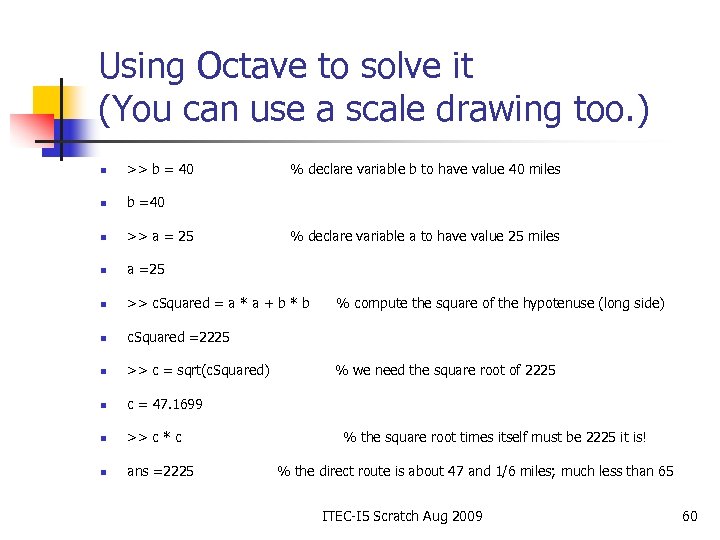 Using Octave to solve it (You can use a scale drawing too. ) n >> b = 40 % declare variable b to have value 40 miles n b =40 n >> a = 25 n a =25 n >> c. Squared = a * a + b * b n c. Squared =2225 n >> c = sqrt(c. Squared) n c = 47. 1699 n >> c * c n ans =2225 % declare variable a to have value 25 miles % compute the square of the hypotenuse (long side) % we need the square root of 2225 % the square root times itself must be 2225 it is! % the direct route is about 47 and 1/6 miles; much less than 65 ITEC-I 5 Scratch Aug 2009 60
Using Octave to solve it (You can use a scale drawing too. ) n >> b = 40 % declare variable b to have value 40 miles n b =40 n >> a = 25 n a =25 n >> c. Squared = a * a + b * b n c. Squared =2225 n >> c = sqrt(c. Squared) n c = 47. 1699 n >> c * c n ans =2225 % declare variable a to have value 25 miles % compute the square of the hypotenuse (long side) % we need the square root of 2225 % the square root times itself must be 2225 it is! % the direct route is about 47 and 1/6 miles; much less than 65 ITEC-I 5 Scratch Aug 2009 60
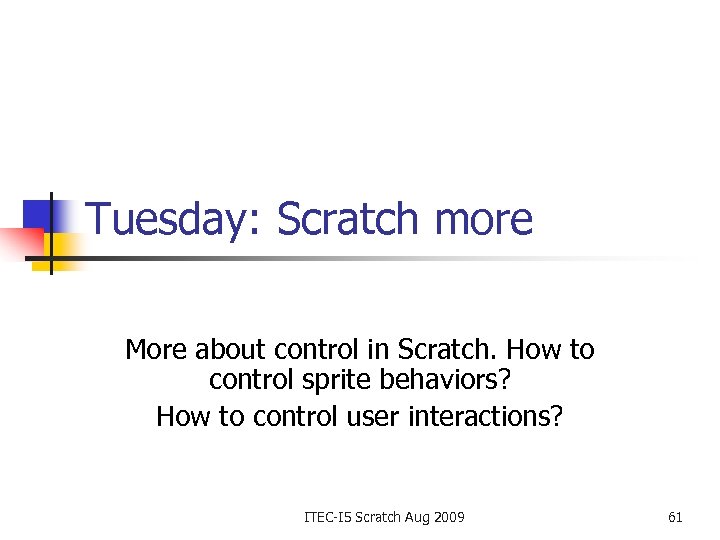 Tuesday: Scratch more More about control in Scratch. How to control sprite behaviors? How to control user interactions? ITEC-I 5 Scratch Aug 2009 61
Tuesday: Scratch more More about control in Scratch. How to control sprite behaviors? How to control user interactions? ITEC-I 5 Scratch Aug 2009 61
 Conditions can be checked n n n Do something if sprite k hits sprite m Do something if a certain key is pressed Do something is some variable takes a certain value ITEC-I 5 Scratch Aug 2009 62
Conditions can be checked n n n Do something if sprite k hits sprite m Do something if a certain key is pressed Do something is some variable takes a certain value ITEC-I 5 Scratch Aug 2009 62
 Interacting with your sprite or story n n n Using mouse Entering a character Asking the user a question ITEC-I 5 Scratch Aug 2009 63
Interacting with your sprite or story n n n Using mouse Entering a character Asking the user a question ITEC-I 5 Scratch Aug 2009 63
 Sprite follows the mouse Try changing the number of steps or the wait time. ITEC-I 5 Scratch Aug 2009 64
Sprite follows the mouse Try changing the number of steps or the wait time. ITEC-I 5 Scratch Aug 2009 64
 Sprites can interact with each other n n n Can detect when colors overlap in space Can detect when sprites bump into edge of the stage Later: See “bouncing balls” example under Simulations under Examples Interact with this simulation Check out the rather complex scripts ITEC-I 5 Scratch Aug 2009 65
Sprites can interact with each other n n n Can detect when colors overlap in space Can detect when sprites bump into edge of the stage Later: See “bouncing balls” example under Simulations under Examples Interact with this simulation Check out the rather complex scripts ITEC-I 5 Scratch Aug 2009 65
 Simple communicating sprites n n n Dog talks to cat in “forever” (infinite) loop Dog sprite sends a message to the cat sprite Cat sprite says “hello” and gives the floor back to the dog ITEC-I 5 Scratch Aug 2009 66
Simple communicating sprites n n n Dog talks to cat in “forever” (infinite) loop Dog sprite sends a message to the cat sprite Cat sprite says “hello” and gives the floor back to the dog ITEC-I 5 Scratch Aug 2009 66
 Cat sprite reacts to dog ITEC-I 5 Scratch Aug 2009 67
Cat sprite reacts to dog ITEC-I 5 Scratch Aug 2009 67
 exercises n n n A) modify the above scripts so that a global variable is used to count how many times the dog says “Hello” B) change the control so that when “Hello” is said 10 times by the dog, the script stops with the dog saying “That’s all folks”. C) change the scripts so that each sprite moves to a random position on the stage before saying “Hello” Show your work to an instructor when you get finished with each part. ITEC-I 5 Scratch Aug 2009 68
exercises n n n A) modify the above scripts so that a global variable is used to count how many times the dog says “Hello” B) change the control so that when “Hello” is said 10 times by the dog, the script stops with the dog saying “That’s all folks”. C) change the scripts so that each sprite moves to a random position on the stage before saying “Hello” Show your work to an instructor when you get finished with each part. ITEC-I 5 Scratch Aug 2009 68
 Check out the break dance example n n n Open examples; music and dance; break dance How does break dancing begin? What are the roles of the sprites? What events are in the scripts? What should happen when the boom box is clicked? ITEC-I 5 Scratch Aug 2009 69
Check out the break dance example n n n Open examples; music and dance; break dance How does break dancing begin? What are the roles of the sprites? What events are in the scripts? What should happen when the boom box is clicked? ITEC-I 5 Scratch Aug 2009 69
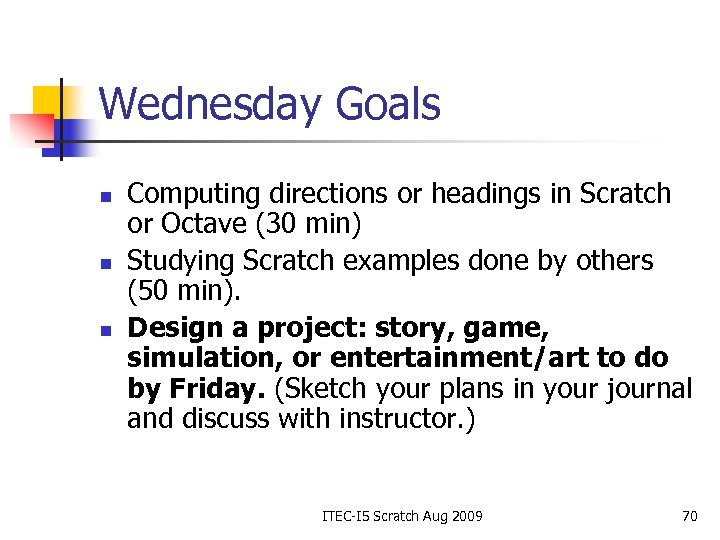 Wednesday Goals n n n Computing directions or headings in Scratch or Octave (30 min) Studying Scratch examples done by others (50 min). Design a project: story, game, simulation, or entertainment/art to do by Friday. (Sketch your plans in your journal and discuss with instructor. ) ITEC-I 5 Scratch Aug 2009 70
Wednesday Goals n n n Computing directions or headings in Scratch or Octave (30 min) Studying Scratch examples done by others (50 min). Design a project: story, game, simulation, or entertainment/art to do by Friday. (Sketch your plans in your journal and discuss with instructor. ) ITEC-I 5 Scratch Aug 2009 70
 Wednesday: practical trig Scale drawings Angles and distances Using trig functions 1) 2) 3) ITEC-I 5 Scratch Aug 2009 71
Wednesday: practical trig Scale drawings Angles and distances Using trig functions 1) 2) 3) ITEC-I 5 Scratch Aug 2009 71
 Heading from point A to point B n n n Suppose my GPS says I am at x=10; y=5 My treasure is at x=22 and y=10 What is my heading and how far do I travel? * (22, 10) N ** (10, 5) ITEC-I 5 Scratch Aug 2009 E 72
Heading from point A to point B n n n Suppose my GPS says I am at x=10; y=5 My treasure is at x=22 and y=10 What is my heading and how far do I travel? * (22, 10) N ** (10, 5) ITEC-I 5 Scratch Aug 2009 E 72
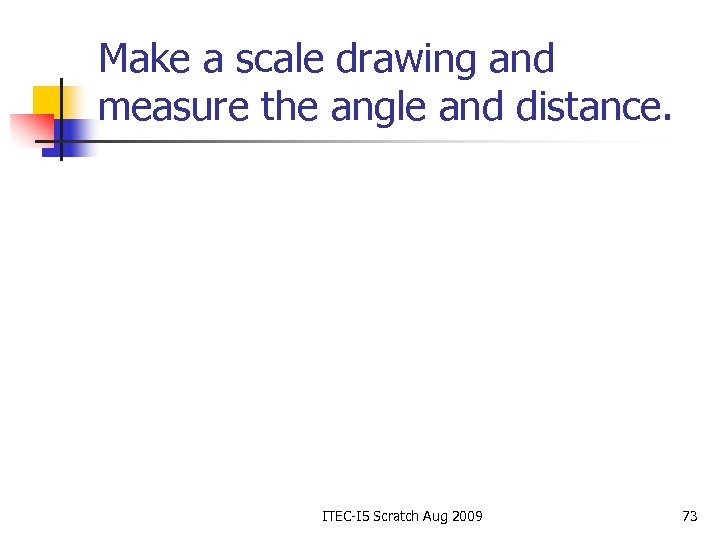 Make a scale drawing and measure the angle and distance. ITEC-I 5 Scratch Aug 2009 73
Make a scale drawing and measure the angle and distance. ITEC-I 5 Scratch Aug 2009 73
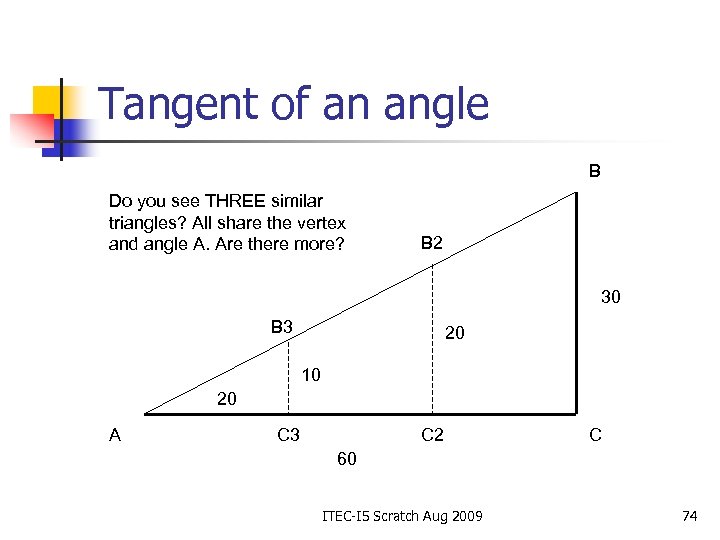 Tangent of an angle B Do you see THREE similar triangles? All share the vertex and angle A. Are there more? B 2 30 B 3 20 10 20 A C 3 C 2 C 60 ITEC-I 5 Scratch Aug 2009 74
Tangent of an angle B Do you see THREE similar triangles? All share the vertex and angle A. Are there more? B 2 30 B 3 20 10 20 A C 3 C 2 C 60 ITEC-I 5 Scratch Aug 2009 74
 Tangent of an angle 10/20 = 0. 5 = ½ B 20/40 = 0. 5 = ½ 30/60 = 0. 5 = ½ B 2 15/30 = 0. 5 = ½ where is this triangle? 5/10 = 0. 5 = ½ where is this triangle? 30 B 3 20 10 20 A C 3 C 2 C 60 ITEC-I 5 Scratch Aug 2009 75
Tangent of an angle 10/20 = 0. 5 = ½ B 20/40 = 0. 5 = ½ 30/60 = 0. 5 = ½ B 2 15/30 = 0. 5 = ½ where is this triangle? 5/10 = 0. 5 = ½ where is this triangle? 30 B 3 20 10 20 A C 3 C 2 C 60 ITEC-I 5 Scratch Aug 2009 75
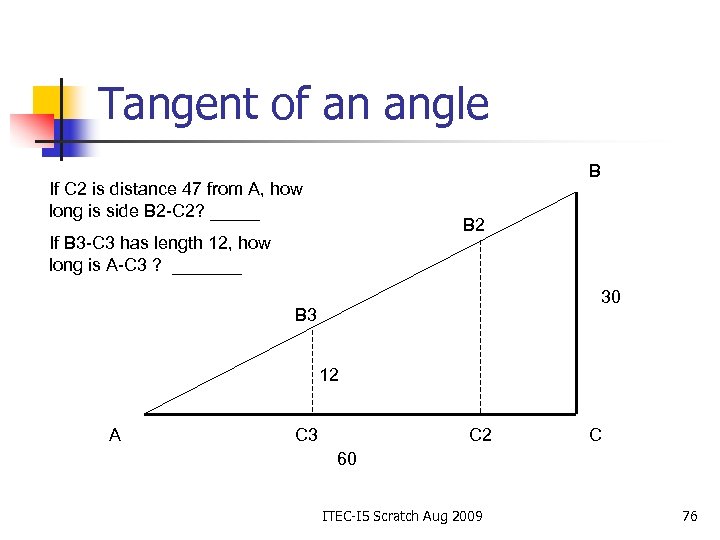 Tangent of an angle B If C 2 is distance 47 from A, how long is side B 2 -C 2? _____ B 2 If B 3 -C 3 has length 12, how long is A-C 3 ? _______ 30 B 3 12 A C 3 C 2 C 60 ITEC-I 5 Scratch Aug 2009 76
Tangent of an angle B If C 2 is distance 47 from A, how long is side B 2 -C 2? _____ B 2 If B 3 -C 3 has length 12, how long is A-C 3 ? _______ 30 B 3 12 A C 3 C 2 C 60 ITEC-I 5 Scratch Aug 2009 76
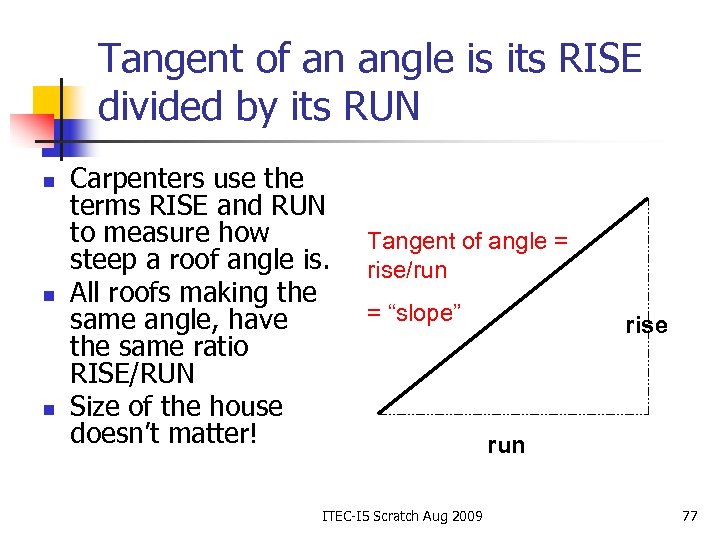 Tangent of an angle is its RISE divided by its RUN n n n Carpenters use the terms RISE and RUN to measure how steep a roof angle is. All roofs making the same angle, have the same ratio RISE/RUN Size of the house doesn’t matter! Tangent of angle = rise/run = “slope” ITEC-I 5 Scratch Aug 2009 rise run 77
Tangent of an angle is its RISE divided by its RUN n n n Carpenters use the terms RISE and RUN to measure how steep a roof angle is. All roofs making the same angle, have the same ratio RISE/RUN Size of the house doesn’t matter! Tangent of angle = rise/run = “slope” ITEC-I 5 Scratch Aug 2009 rise run 77
 Using the hypotenuse and one leg n n n B 10 more minutes and a few slides needed to do this >> rise = 6 n >> hyp = 10 n >> angle. A = asind(rise/hyp) Hyp = 10 n C A n angle. A = 36. 8699 >> sind (36. 8699) %in degree n Rise =6 ans = 0. 6000 n sin A = rise / hyp ITEC-I 5 Scratch Aug 2009 78
Using the hypotenuse and one leg n n n B 10 more minutes and a few slides needed to do this >> rise = 6 n >> hyp = 10 n >> angle. A = asind(rise/hyp) Hyp = 10 n C A n angle. A = 36. 8699 >> sind (36. 8699) %in degree n Rise =6 ans = 0. 6000 n sin A = rise / hyp ITEC-I 5 Scratch Aug 2009 78
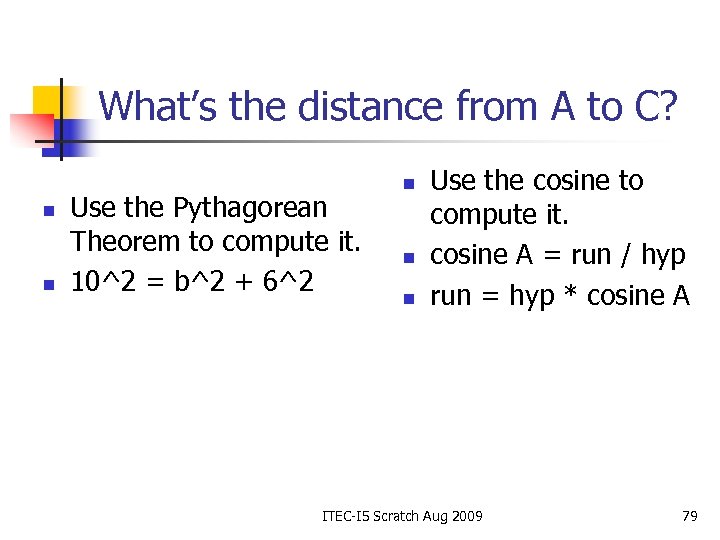 What’s the distance from A to C? n n Use the Pythagorean Theorem to compute it. 10^2 = b^2 + 6^2 n n n Use the cosine to compute it. cosine A = run / hyp run = hyp * cosine A ITEC-I 5 Scratch Aug 2009 79
What’s the distance from A to C? n n Use the Pythagorean Theorem to compute it. 10^2 = b^2 + 6^2 n n n Use the cosine to compute it. cosine A = run / hyp run = hyp * cosine A ITEC-I 5 Scratch Aug 2009 79
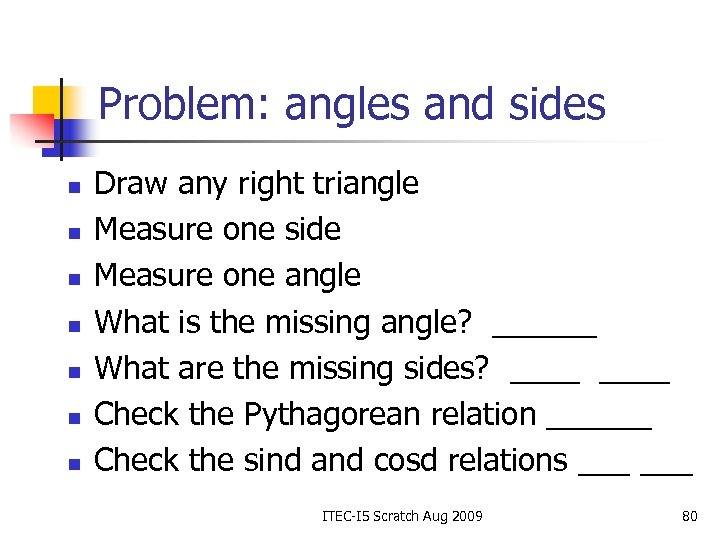 Problem: angles and sides n n n n Draw any right triangle Measure one side Measure one angle What is the missing angle? ______ What are the missing sides? ____ Check the Pythagorean relation ______ Check the sind and cosd relations ___ ITEC-I 5 Scratch Aug 2009 80
Problem: angles and sides n n n n Draw any right triangle Measure one side Measure one angle What is the missing angle? ______ What are the missing sides? ____ Check the Pythagorean relation ______ Check the sind and cosd relations ___ ITEC-I 5 Scratch Aug 2009 80
 Angles in Octave n >> rise = 20 n rise =20 n >> run = 40 n >> angle = atand(rise/run) n angle = 26. 5651 n >> rise = 30 n rise =30 n >> angle = atand(rise/run) n angle = 36. 8699 % function or operator atand gives your angle in degrees ITEC-I 5 Scratch Aug 2009 81
Angles in Octave n >> rise = 20 n rise =20 n >> run = 40 n >> angle = atand(rise/run) n angle = 26. 5651 n >> rise = 30 n rise =30 n >> angle = atand(rise/run) n angle = 36. 8699 % function or operator atand gives your angle in degrees ITEC-I 5 Scratch Aug 2009 81
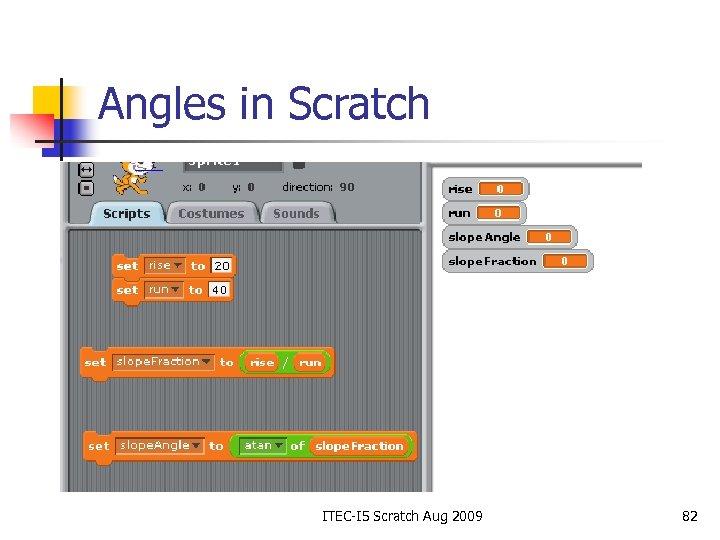 Angles in Scratch ITEC-I 5 Scratch Aug 2009 82
Angles in Scratch ITEC-I 5 Scratch Aug 2009 82
 Computing the angle Execute each of the 3 code segments. Slope is 0. 5 or ½ The angle is about 27 degrees. ITEC-I 5 Scratch Aug 2009 83
Computing the angle Execute each of the 3 code segments. Slope is 0. 5 or ½ The angle is about 27 degrees. ITEC-I 5 Scratch Aug 2009 83
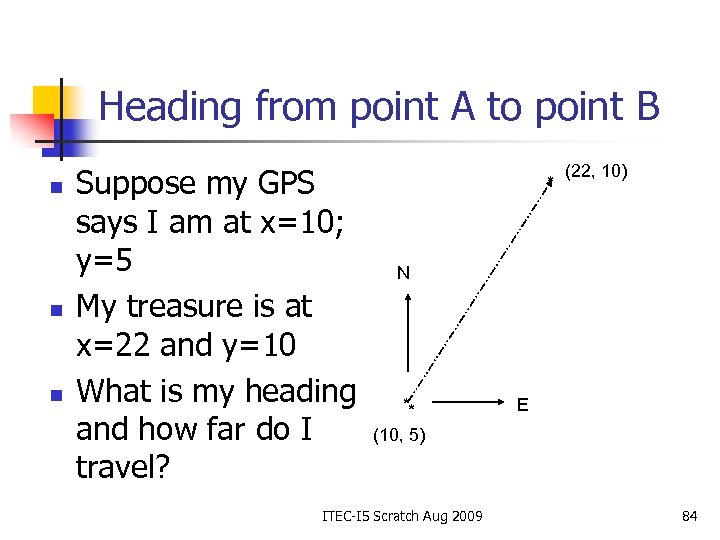 Heading from point A to point B n n n Suppose my GPS says I am at x=10; y=5 My treasure is at x=22 and y=10 What is my heading and how far do I travel? * (22, 10) N ** (10, 5) ITEC-I 5 Scratch Aug 2009 E 84
Heading from point A to point B n n n Suppose my GPS says I am at x=10; y=5 My treasure is at x=22 and y=10 What is my heading and how far do I travel? * (22, 10) N ** (10, 5) ITEC-I 5 Scratch Aug 2009 E 84
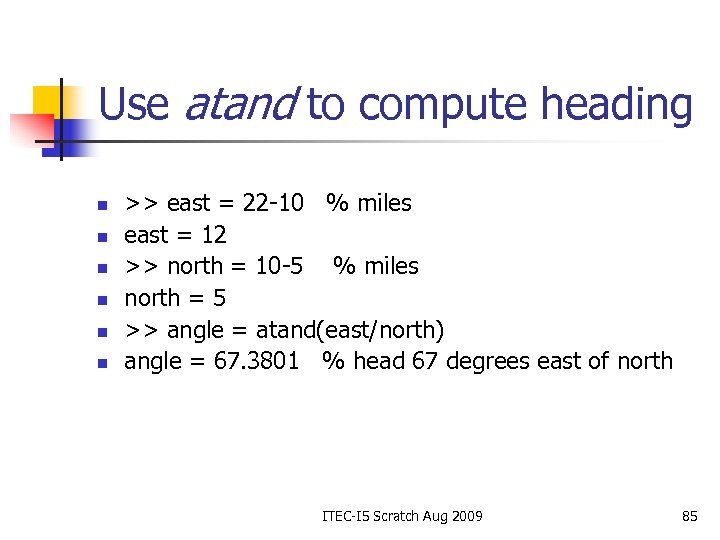 Use atand to compute heading n n n >> east = 22 -10 % miles east = 12 >> north = 10 -5 % miles north = 5 >> angle = atand(east/north) angle = 67. 3801 % head 67 degrees east of north ITEC-I 5 Scratch Aug 2009 85
Use atand to compute heading n n n >> east = 22 -10 % miles east = 12 >> north = 10 -5 % miles north = 5 >> angle = atand(east/north) angle = 67. 3801 % head 67 degrees east of north ITEC-I 5 Scratch Aug 2009 85
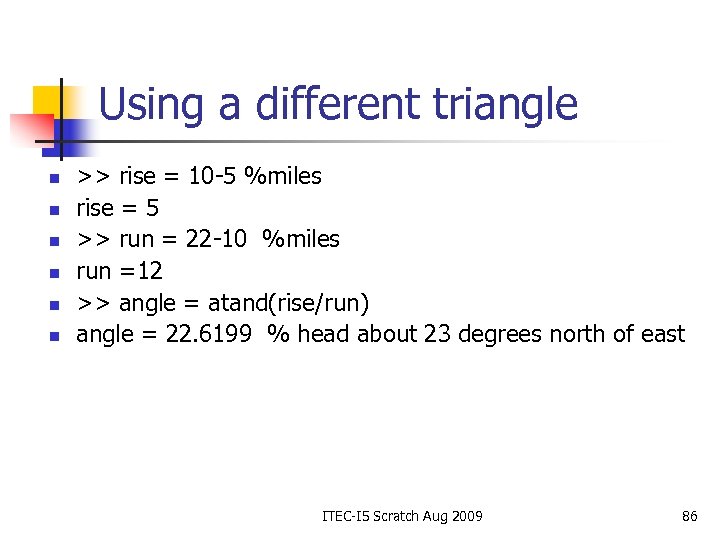 Using a different triangle n n n >> rise = 10 -5 %miles rise = 5 >> run = 22 -10 %miles run =12 >> angle = atand(rise/run) angle = 22. 6199 % head about 23 degrees north of east ITEC-I 5 Scratch Aug 2009 86
Using a different triangle n n n >> rise = 10 -5 %miles rise = 5 >> run = 22 -10 %miles run =12 >> angle = atand(rise/run) angle = 22. 6199 % head about 23 degrees north of east ITEC-I 5 Scratch Aug 2009 86
 Exercises in computing angles n n A) Repeat the above Octave solutions in Scratch B) Find the angles A at the right (angle C=90) A 30 20 C C 24 A 45 36 50 A ITEC-I 5 Scratch Aug 2009 C 87
Exercises in computing angles n n A) Repeat the above Octave solutions in Scratch B) Find the angles A at the right (angle C=90) A 30 20 C C 24 A 45 36 50 A ITEC-I 5 Scratch Aug 2009 C 87
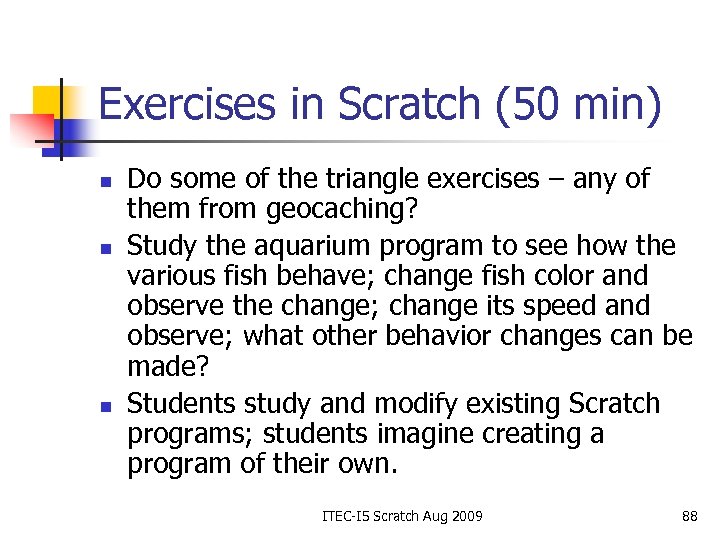 Exercises in Scratch (50 min) n n n Do some of the triangle exercises – any of them from geocaching? Study the aquarium program to see how the various fish behave; change fish color and observe the change; change its speed and observe; what other behavior changes can be made? Students study and modify existing Scratch programs; students imagine creating a program of their own. ITEC-I 5 Scratch Aug 2009 88
Exercises in Scratch (50 min) n n n Do some of the triangle exercises – any of them from geocaching? Study the aquarium program to see how the various fish behave; change fish color and observe the change; change its speed and observe; what other behavior changes can be made? Students study and modify existing Scratch programs; students imagine creating a program of their own. ITEC-I 5 Scratch Aug 2009 88
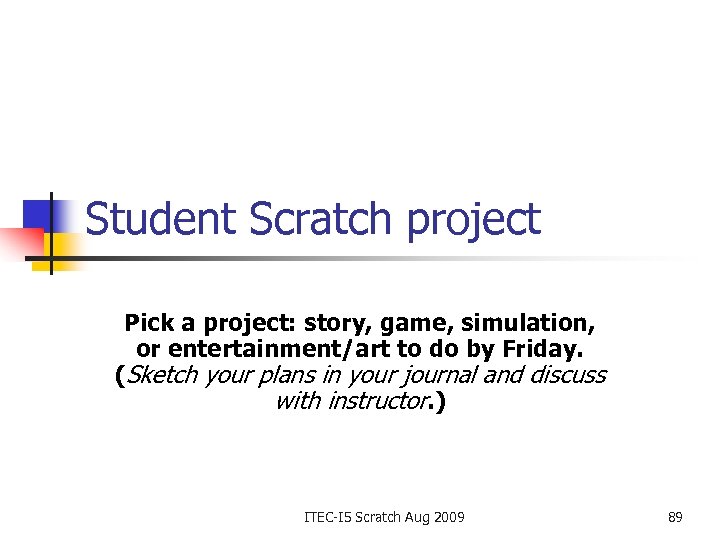 Student Scratch project Pick a project: story, game, simulation, or entertainment/art to do by Friday. (Sketch your plans in your journal and discuss with instructor. ) ITEC-I 5 Scratch Aug 2009 89
Student Scratch project Pick a project: story, game, simulation, or entertainment/art to do by Friday. (Sketch your plans in your journal and discuss with instructor. ) ITEC-I 5 Scratch Aug 2009 89
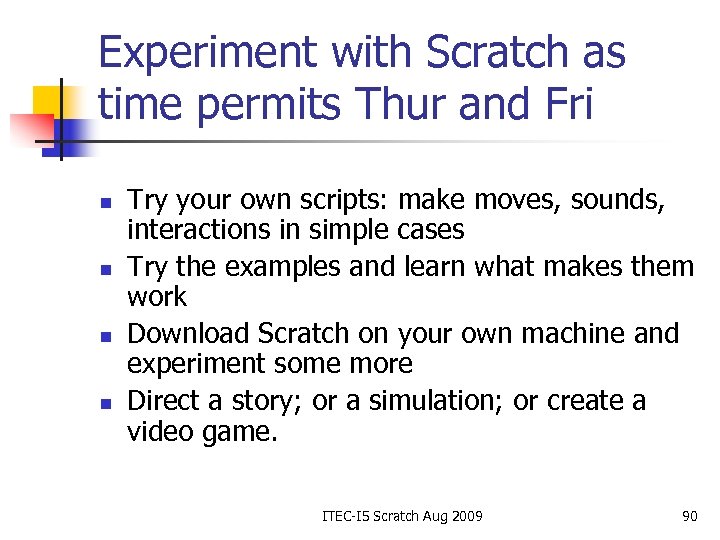 Experiment with Scratch as time permits Thur and Fri n n Try your own scripts: make moves, sounds, interactions in simple cases Try the examples and learn what makes them work Download Scratch on your own machine and experiment some more Direct a story; or a simulation; or create a video game. ITEC-I 5 Scratch Aug 2009 90
Experiment with Scratch as time permits Thur and Fri n n Try your own scripts: make moves, sounds, interactions in simple cases Try the examples and learn what makes them work Download Scratch on your own machine and experiment some more Direct a story; or a simulation; or create a video game. ITEC-I 5 Scratch Aug 2009 90


